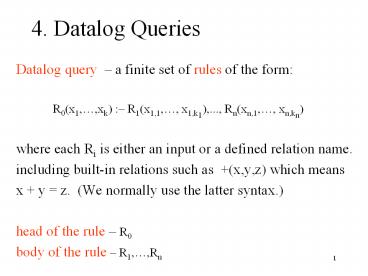4. Datalog Queries - PowerPoint PPT Presentation
Title:
4. Datalog Queries
Description:
Travel(Omaha, Lincoln, 60) Travel(Omaha, Lincoln, 60):- Go(Omaha, 0, Lincoln, 60) ... Kansas_City,210):- Travel(Omaha,Lincoln,60), Go(Lincoln,60,Kansas_City,210) ... – PowerPoint PPT presentation
Number of Views:77
Avg rating:3.0/5.0
Title: 4. Datalog Queries
1
4. Datalog Queries
- Datalog query a finite set of rules of the
form - R0(x1,,xk) R1(x1,1,, x1,k1),...,
Rn(xn,1,, xn,kn) - where each Ri is either an input or a defined
relation name. - including built-in relations such as (x,y,z)
which means - x y z. (We normally use the latter syntax.)
- head of the rule R0
- body of the rule R1,,Rn
2
- Example
- Find the SSN and the tax.
- Tax_Due(s, t) Taxrecord(s, w, i, c),
Taxtable(inc, t), - wic inc.
- Find the streets that can be reached from
(x0,y0). - Reach(n) Street(n, x0, y0).
- Reach(n) Reach(m), Street(m, x, y),
Street(n, x, y). - Find the time to travel from x to y.
- Travel(x, y, t) Go(x, 0, y, t).
- Travel(x, y, t) Travel(x, z, t2), Go(z,
t2, y, t).
3
- Example
- Find town points covered by a radio station
- Covered(x2, y2) Broadcast(n, x, y), Town(t,
x2, y2), - Parameters(n, s,
blat, blong), - Parameters(t, s2,
tlat, tlong), - x2 x (tlat
blat), - y2 y
(tlong blong).
4
- 4.2 Datalog with Sets
- Example Hamiltonian Cycle
- Input
- Vertices(S) where S is a set of
vertices - Edge (c1, c2) if there is an edge from
c1 to c2 - Start(c) where c is start city
name - Output
- Path (c, B) if there is a path
from c that uses - all
vertices except those in B. - Hamiltonian (c) if there is a Hamiltonian
path.
5
- Base case Path is a single vertex. All vertices
- except the start vertex is
unvisited. - Path(X1, B) Vertices(A), Start(X1), B
A \ X1. - Recursion
- a
path to X1 with B unvisited
-
exists if there is - Path(X1, B) Path(X2, A), a path to X2
with A unvisited - Edge(X2, X1), and
an edge from X2 to X1, - X1 ? A,
which is unvisited, and - B A \ X1. B
is A minus X1
6
- If there is a path from start to X2 that visits
all - vertices and an edge from X2 to start, then there
- is a Hamiltonian cycle.
- Hamiltonian(X1) Path(X2, ?),
- Edge(X2, X1),
- Start(X1).
7
- 4.4 Datalog with Abstract Data Types
- Example
- Streets(Name, Extent) where extent is a set of
2D points. Let (x0, y0) be a start location. - Express the reach relation
- Reach(n) Street(n, Extent), (x0,y0) ?
Extent. - Reach(n) Reach(m), Street(m, S1), Street(n,
S2), - S1 ? S2 ? ?
8
- 4.5 Semantics
- Rule instantiation substitution of variables by
constants - ?Q,I R(a1,..ak) R(a1,.ak) has a proof
using query Q - and input
database I, iff - R represents input relation r and (a1,.ak) ? r ,
or - There is some rule and instantiation
- R(a1,,ak)R1(a1,1,,a1,k1),, Rn(an,1,, an,
kn). - where ?Q,I Ri(ai,1,,ai,ki) for each 1 ? i ? n
.
9
- Example
- Reach(Vine)
- Reach(Vine) Street(Vine, 5, 2).
- Reach(Bear)
- Reach(Bear) Reach(Vine), Street(Vine, 5,
12), - Street(Bear,
5, 12). - Reach(Hare)
- Reach(Hare) Reach(Bear),
Street(Bear, 8, 13), - Street(Hare,
8, 13).
10
- Example By the input database (Figure 1.2)
- Go(Omaha, 0, Lincoln, 60)
- Go(Lincoln, 60, Kansas_City, 210)
- Go(Kansas_City, 210, Des_Moines, 390)
- Go(Des_Moines, 390, Chicago, 990)
- We also have
- Travel(Omaha, Lincoln, 60)
- Travel(Omaha, Lincoln, 60)- Go(Omaha, 0,
Lincoln, 60) - Travel(Omaha, Kansas_City, 210)
- Travel(Omaha,Kansas_City,210)-
Travel(Omaha,Lincoln,60), - Go(Lincoln,60,Kansas_City
,210).
11
(No Transcript)
12
- Proof-based semantics derived relations are the
set - of tuples
that can be proven. - Fixed point semantics an interpretation of the
derived - relations
such that nothing new - can be
proven. - Least fixed point semantics smallest possible
FP semantics. - Proof-based semantics Least fixed point
semantics

